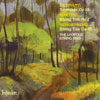Dohnányi Serenade, Op 10; Martinu String Trio No 2; Schoenberg String Trio, Op 45
Three players whose persuasive musicianship is consistently revealing
View record and artist detailsRecord and Artist Details
Composer or Director: Arnold Schoenberg, Bohuslav (Jan) Martinu, Ernö Dohnányi
Genre:
Chamber
Label: Hyperion
Magazine Review Date: 9/2005
Media Format: CD or Download
Media Runtime: 0
Mastering:
Stereo
Catalogue Number: CDA67429

Tracks:
| Composition | Artist Credit |
|---|---|
| Serenade |
Ernö Dohnányi, Composer
Ernö Dohnányi, Composer Leopold String Trio |
| String Trio |
Arnold Schoenberg, Composer
Arnold Schoenberg, Composer Leopold String Trio |
| String Trio No. 2 |
Bohuslav (Jan) Martinu, Composer
Bohuslav (Jan) Martinu, Composer Leopold String Trio |
Author: Rob Cowan
An extraordinary piece, Schoenberg’s 1946 String Trio: uncompromising creative rigour applied to genuinely expressive ends. Terse, aphoristic, haunting and disruptive, the work is cast as a single movement divided into three sections by intervening episodes. Perhaps its most gripping section (track 10) is the last in which, after a spell of agitation, a loud pizzicato signals softer music (1’06”) including a motif (1’14”) that resembles a key motif from the finale of Sibelius’s Fourth Symphony. Both works were written when their composers were recovering from potentially fatal illness – in Schoenberg’s case a heart attack, in Sibelius’s a throat tumour – and I’m tempted to think of it as a ‘mortality’ motif.
The beauty of this recording by the Leopold String Trio is in the way the players draw out the music’s full harmonic implications, more so than the Juilliards (on their second recording) or the LaSalles, whose leader tends to dominate. All manner of devices are used in pursuit of maximum colour, including col legno, harmonics and pizzicato. Comparisons favour the LaSalles only in terms of rhythmic projection, which is uniquely clear at, for example, the beginning of that last section; however, the Leopolds score in their rapturous playing of the quieter music.
The rest of the programme marks a maximum contrast with Schoenberg’s austerity. Martinu’s energetic Second String Trio (1935) is typical in its combination of lyrical ardour and Rousselian busy-ness. The Leopolds play with gusto, much as they do in the earliest and most approachable piece, Dohnányi’s Serenade, Op 10, a tuneful and well-constructed piece stunningly recorded back in the early 1940s by the Heifetz-Primrose-Feuermann Trio. That performance was a tour de force the like of which we have never heard since, but the Leopold Trio have their own strengths, not least a warm, pooled tone, a relaxed demeanour and an ability to search out the subtler aspects of the score. The sound is consistently excellent; add Calum MacDonald’s authoritative notes and you have a confident recommendation.
The beauty of this recording by the Leopold String Trio is in the way the players draw out the music’s full harmonic implications, more so than the Juilliards (on their second recording) or the LaSalles, whose leader tends to dominate. All manner of devices are used in pursuit of maximum colour, including col legno, harmonics and pizzicato. Comparisons favour the LaSalles only in terms of rhythmic projection, which is uniquely clear at, for example, the beginning of that last section; however, the Leopolds score in their rapturous playing of the quieter music.
The rest of the programme marks a maximum contrast with Schoenberg’s austerity. Martinu’s energetic Second String Trio (1935) is typical in its combination of lyrical ardour and Rousselian busy-ness. The Leopolds play with gusto, much as they do in the earliest and most approachable piece, Dohnányi’s Serenade, Op 10, a tuneful and well-constructed piece stunningly recorded back in the early 1940s by the Heifetz-Primrose-Feuermann Trio. That performance was a tour de force the like of which we have never heard since, but the Leopold Trio have their own strengths, not least a warm, pooled tone, a relaxed demeanour and an ability to search out the subtler aspects of the score. The sound is consistently excellent; add Calum MacDonald’s authoritative notes and you have a confident recommendation.
Discover the world's largest classical music catalogue with Presto Music.

Gramophone Digital Club
- Digital Edition
- Digital Archive
- Reviews Database
- Full website access
From £8.75 / month
Subscribe
Gramophone Full Club
- Print Edition
- Digital Edition
- Digital Archive
- Reviews Database
- Full website access
From £11.00 / month
Subscribe
If you are a library, university or other organisation that would be interested in an institutional subscription to Gramophone please click here for further information.




